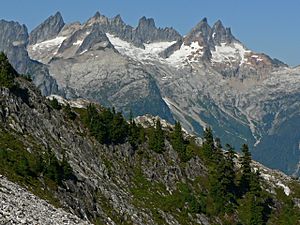McMillan Spire facts for kids
Quick facts for kids McMillan Spire |
|
|---|---|

McMillan Spires in the Picket Range
|
|
| Highest point | |
| Elevation | 8,004 ft (2,440 m) |
| Prominence | 600 ft (180 m) |
| Geography | |
| Location | Whatcom County, Washington, U.S. |
| Parent range | Cascade Range |
| Topo map | USGS Mount Challenger |
| Climbing | |
| First ascent | 1940 Fred Beckey |
McMillan Spire is a tall mountain peak in the Picket Range of Washington. It stands at about 8,004 feet (2,439 meters) high. This mountain is located inside the beautiful North Cascades National Park.
McMillan Spire is close to other famous peaks. It is about 0.75 miles (1.2 km) east of Mount Degenhardt. It is also about 0.47 miles (0.76 km) east of Inspiration Peak. There is a smaller peak nearby called East McMillan Spire. It is about 0.14 miles (0.23 km) east of McMillan Spire. Together, these two peaks are often called the McMillan Spires. To the west of the peak, you can find the Terror Glacier.
Weather and Climate in the Mountains
McMillan Spire is in a special weather area called the marine west coast climate zone. This means it gets a lot of moisture from the Pacific Ocean. Most of the weather systems start over the Pacific. They then travel northeast towards the Cascade Range.
When these weather systems reach the North Cascades, the tall mountains force the air upwards. This process is called Orographic lift. As the air rises, it cools down and drops its moisture. This moisture falls as rain or snowfall on the mountains. Because of this, the western side of the North Cascades gets a lot of precipitation. This is especially true during the winter months, when heavy snow falls.
In winter, the weather is often cloudy. However, during the summer, high-pressure systems over the Pacific Ocean become stronger. This often leads to clear skies and sunshine. Because of the ocean's influence, the snow here tends to be wet and heavy. This can create a high risk of avalanches, which are dangerous slides of snow.
How the Mountains Were Formed
The North Cascades area has some of the most rugged and dramatic landscapes. You can see sharp, craggy peaks, long ridges, and deep glacial valleys. These amazing features were created by geological events that happened millions of years ago. These events caused big changes in the land's elevation. This led to different climates and various types of plants in different areas.
The Cascade Range started forming millions of years ago. This was during a time called the late Eocene Epoch. The North American Plate (a huge piece of Earth's crust) was slowly moving over the Pacific Plate. This movement caused many volcanic eruptions. Also, small pieces of Earth's crust, called terranes, came together. This helped create the North Cascades about 50 million years ago.
Later, during the Pleistocene period, which began over two million years ago, glaciers played a big role. Huge sheets of ice moved across the land many times. As they moved, they carved out the landscape and left behind rock debris. The "U"-shaped valleys you see today were formed by these glaciers. The combination of the land being pushed up (called uplift) and cracks forming in the Earth (called faulting) along with glaciation, created the tall peaks and deep valleys of the North Cascades.





